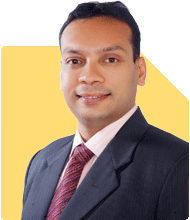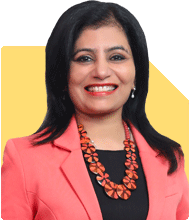Ramalingam Kalirajan |2636 Answers |Ask -Follow
Mutual Funds, Financial Planning Expert - Answered on May 07, 2024
He has an MBA in finance from the University of Madras and is a certified financial planner.
He is the director and chief financial planner at Holistic Investment, a Chennai-based firm that offers financial planning and wealth management advice.... more

Hi. I am 42 years old and an aggresive investor and I started investing 1 lac per month in SIP in 2019. These are my current funds : CANARA ROBECO EMERGING EQUITIES - REGULAR GROWTH HDFC MID-CAP OPPORTUNITIES FUND - REGULAR PLAN - GROWTH SBI FLEXICAP FUND - REGULAR PLAN - GROWTH ICICI PRUDENTIAL BLUECHIP FUND - GROWTH NIPPON INDIA SMALL CAP FUND - GROWTH PLAN GROWTH OPTION I now intend to invest another 1 lac per month in the following funds : Quant Small Cap Fund - Direct Plan - Growth Motilal Oswal Midcap Fund - Direct Plan - Growth Canara Robeco Infrastructure - Direct Plan - Growth Quant Large and Mid Cap Fund - Direct Plan - Growth Could you share your views on the new funds I intend to invest and also on my overall portfolio please ?
Your current funds show a balanced mix catering to different segments of the market. Canara Robeco Emerging Equities, HDFC Mid-Cap Opportunities, SBI FlexiCap, ICICI Prudential Bluechip, and Nippon India Small Cap Fund cover various sectors, providing a diversified portfolio.
Adding more funds to your investment kitty is a bold move. Let's discuss each new addition briefly.
Quant Small Cap Fund: Investing in small-cap companies can offer high growth potential but comes with higher risk. Keep an eye on its performance.
Motilal Oswal Midcap Fund: Mid-cap funds are known for stability and growth. It could complement your existing mid-cap investment.
Canara Robeco Infrastructure: Infrastructure funds can benefit from government initiatives and economic growth. However, they can be volatile due to sector-specific risks.
Quant Large and Mid Cap Fund: This fund combines large and mid-cap stocks, offering a balanced approach. Monitor its performance and align it with your goals.
Considering your aggressive investment approach, these new additions seem aligned with your strategy. However, always keep an eye on market trends and review your portfolio regularly.
Moreover, instead of investing directly, consider investing in regular plans through a Mutual Fund Distributor (MFD). Here's why:
By investing through a Regular Plan, you can access professional advice and guidance from an experienced Mutual Fund Distributor.
MFDs can help you navigate through the complexities of the market, select suitable funds based on your risk profile, and monitor your investments regularly.
Regular plans often offer additional services, such as portfolio reviews, financial planning, and timely updates on market trends and fund performance.
Investing through an MFD ensures that you receive ongoing support and assistance, helping you make informed decisions and stay on track towards your financial goals.
Overall, by diversifying your investments and leveraging the expertise of a Mutual Fund Distributor, you can enhance the effectiveness of your investment strategy and optimize your chances of long-term success.
You may like to see similar questions and answers below
Omkeshwar Singh | Answer |Ask -Follow
Head, Rank MF - Answered on Apr 11, 2022
Ramalingam Kalirajan |2636 Answers |Ask -Follow
Mutual Funds, Financial Planning Expert - Answered on Apr 16, 2024
Ramalingam Kalirajan |2636 Answers |Ask -Follow
Mutual Funds, Financial Planning Expert - Answered on May 17, 2024
Ramalingam Kalirajan |2636 Answers |Ask -Follow
Mutual Funds, Financial Planning Expert - Answered on Apr 27, 2024
Ramalingam Kalirajan |2636 Answers |Ask -Follow
Mutual Funds, Financial Planning Expert - Answered on May 14, 2024
Krishna Kumar |285 Answers |Ask -Follow
Workplace Expert - Answered on May 19, 2024
Krishna Kumar |285 Answers |Ask -Follow
Workplace Expert - Answered on May 19, 2024
Krishna Kumar |285 Answers |Ask -Follow
Workplace Expert - Answered on May 19, 2024
Krishna Kumar |285 Answers |Ask -Follow
Workplace Expert - Answered on May 19, 2024
Archana Deshpande |36 Answers |Ask -Follow
Image Coach, Soft Skills Trainer - Answered on May 19, 2024
Archana Deshpande |36 Answers |Ask -Follow
Image Coach, Soft Skills Trainer - Answered on May 19, 2024
Archana Deshpande |36 Answers |Ask -Follow
Image Coach, Soft Skills Trainer - Answered on May 19, 2024
Archana Deshpande |36 Answers |Ask -Follow
Image Coach, Soft Skills Trainer - Answered on May 19, 2024
Ramalingam Kalirajan |2636 Answers |Ask -Follow
Mutual Funds, Financial Planning Expert - Answered on May 19, 2024
Ramalingam Kalirajan |2636 Answers |Ask -Follow
Mutual Funds, Financial Planning Expert - Answered on May 19, 2024





















